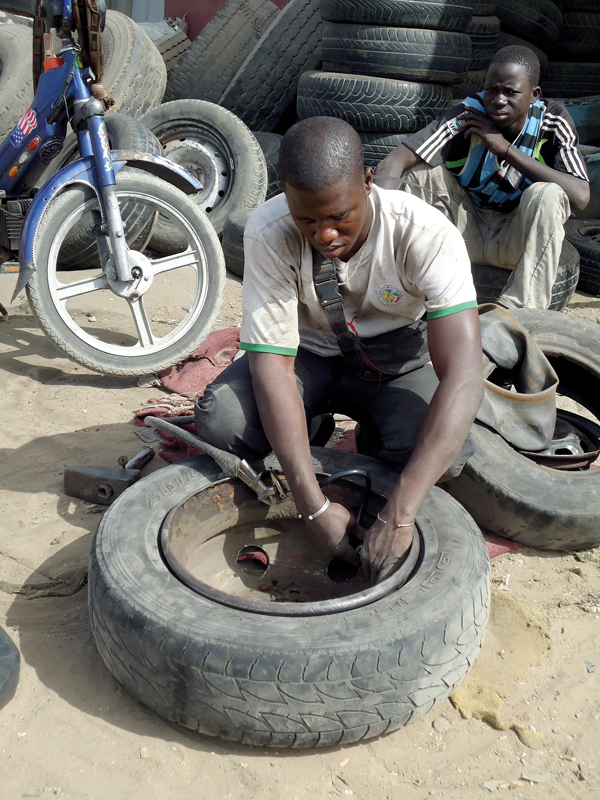
Senegal is located at the westernmost tip of the African continent, in the Atlantic Ocean, at the intersection of Europe, Africa and the Americas, and at a crossroads of major sea and air routes. The country is bordered to the north by Mauritania, to the east by Mali, to the south by Guinea and Guinea Bissau, to the west by the Gambia, and over 500 kilometres by the Atlantic Ocean. Dakar, the capital, is a peninsula located in the far west.
The territory now known as Senegal has a long and rich political and cultural history. It was long part of the ancient kingdoms of Ghana and Djolof and was contested by the United Kingdom, France, Portugal, and the Netherlands before becoming a French colony. Since independence in 1960, Senegal has been one of the most politically stable countries in Africa, being one of the only African countries without a coup d'état. The three political alternations have been peaceful. In power since 2012, President Macky Sall won a second five-year term in February 2019.
A flat country with sandy soils not exceeding 130 metres in altitude, except at the south-eastern border with Guinea, Senegal owes its name to the river (1700 kilometres) which borders it to the east and north and has its origin in the Fouta-Djalon in Guinea. The Senegal River forms the border with Mauritania and its main tributary marks the border with Mali. In the centre, the Saloum flows into the sea through a long estuary cluttered with mangroves. These rivers are subject to seasonal variations (dry season and rainy season), except for the Senegal River, which has been developed for irrigation of its delta.
Senegal’s geography is not very favourable to agriculture. Indeed, although the south is very rainy, most of the country is in a dry Sahelian zone. Watercourses are rare and, combined with the flatness of the country and the low flow of rivers, this constitutes a serious natural barrier to the agricultural development of the regions. Fishing, which was for a long time one of the main natural products of the country, is in rapid decline. Nevertheless, the agricultural sector employs more than 50% of the active population. The Plan Sénégal Émergent, the strategy for Senegal's economic and social policy up to 2035, aims, among other things, to develop the agricultural sector. In this context, the PSE supports the cultivation of rice, onions, groundnuts and off-season fruits and vegetables to strengthen food security and increase exports to other countries, particularly in Europe.
Four main ethnic groups (Wolof, Halpulaaren, Serer and Diola) make up the Senegalese population, the vast majority of which are Muslim. A common national language, Wolof, is spoken throughout the country, as well as in Gambia. However, education is provided in French.
The Senegalese population is very unevenly distributed among the country's 14 regions. The Dakar region, which occupies 0.3% of the area, is home to almost 20% of the total population. According to estimations, two million Senegalese work outside the country.
Senegal, which was once a prosperous country, went into economic decline after the great droughts of the 1970s. The industry was based on groundnut oil mills, fishing and, to a lesser extent, cotton. It collapsed with the fall in world commodity prices, the overexploitation of resources and the transformation of eating habits in Europe, the main importer of Senegalese products. The government did not recognise this decline in time and did not put in place a sufficient alternative and restructuring policy. The informal sector continues to dominate the economic activity of the Senegalese population.
In 1993, after seeing its economy contract by 2.1%, Senegal made a significant turnaround with an average real GDP growth of over 5% per year (1995-2007). In 2009, the country was affected by the global economic downturn and GDP growth fell below 2%. In recent years, economic growth has recovered to over 6% between 2014 and 2018. However, this growth has been hampered by the Covid-19 crisis and the border closures, curfew and physical distancing adopted in this context. GDP growth has declined from 6.1% in 2021 to 4.8% in 2022.
Today, the recovery momentum is further hampered by the conflict in Ukraine, which reduces private consumption and investment due to rising food and energy prices and increasing uncertainty. In addition, the high unemployment rate of 22% continues to prompt migrants to flee Senegal in search of better job opportunities in Europe.
Luxembourg Cooperation activities in Senegal began in 1990 with the rehabilitation and extension of health facilities at the Saint-Louis Hospital. Similarly, the first Indicative Cooperation Programme (ICP) between the Republic of Senegal and the Grand Duchy of Luxembourg, signed in January 2003, focused on the Dakar - Saint-Louis geographical axis. Today, Luxembourg Cooperation is implementing ICP IV, which focuses on the vocational and technical training and health sectors.
Evolution of activities in Senegal (in thousand EUR)
Distribution of the 2022 disbursements by sector
All projects in Senegal
Projects in preparation in Senegal
| Project Code | Title | Sectors | Indicative Budget |
|---|---|---|---|
| SEN/036 | Health and social protection | Health | 34,000,000 EUR |
| SEN/037 | Vocational and technical training, employability and socio-professional integration of young people and women | Education, vocationnal training and employment | 38,250,000 EUR |
